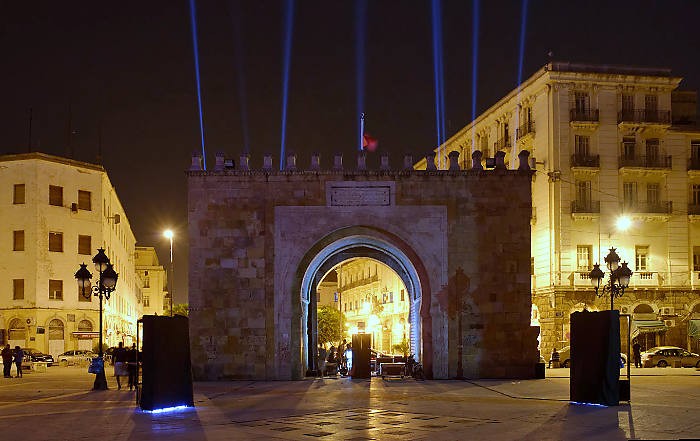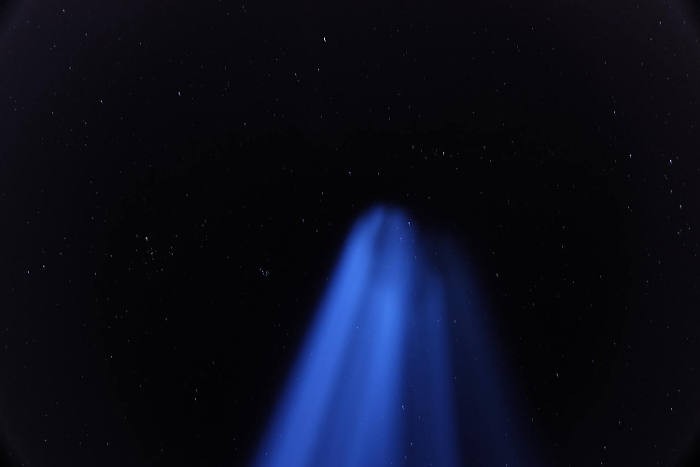


Arche Bab El Bhar, dans le cœur du vieux Tunis, à deux pas de la Médina. Il est 19h. Un bus klaxonne, le flot de la circulation comme fond sonore. Deux monolithes noirs, massifs, sont posés sur la place publique. Les gens transitent, rentrent du travail, de leurs courses. Certains, ignorent l’objet. D’autres s’arrêtent, interpelés par la lumière qui émane du dessous des monolithes, scintillant aléatoirement. Intrigués, ils effleurent la surface. Un flash lumineux provient de l’arche en même temps qu’un son. Un son différant de celui de cette ville. Un son inorganique. Alors ils touchent un peu plus, pour voir. Un enfant a remarqué aussi. Il se joint. L’interaction est différente à deux. Le son se fait plus cristallin. Des faisceaux semblent vaciller dans le ciel déjà bien obscurci par la nuit.
Bientôt, une poignée de personnes poussent sur la dalle tactile, envoie les enfants à se joindre via le deuxième monolithe… Les faisceaux sont à leur paroxysme, les sons qui proviennent de l’arche sont maintenant ceux d’une nature florissante, de pépiements joyeux écrasant ceux du trafic.
La disparition de ces sons naturels dans la ville provoque, en plus d’une tension écologique, la disparition d’un lien, de la possibilité de ce que Michel Hulin appelle « la Mystique Sauvage » : en se retrouvant confronté à un élément naturel nous dépassant, sur lequel notre contrôle semble extrêmement réduit, Elementa questionne la rupture que la ville opère quant à de potentielles expériences de Mystique Sauvage. En dialogue avec le public, l’installation pose la question de la place de l’individu dans la ville. En réagissant en fonction du nombre de personnes touchant les monolithes, l’œuvre, apparentée à un cœur lumineux, remet l’idée de collectif au centre des nécessités de l’art de vivre urbain. La responsabilité de l’individu face à son environnement devient palpable.
Arche Bab El Bhar, in the heart of old Tunis, close to the Medina. It’s 7 p.m. A honking bus, the constant hum traffic in the background.
Two massive black monoliths are placed in the public square. People pass by, come home from work, carrying their shopping. Some ignore the object. Others stop, challenged by the light which emanates from below the monoliths, shimmering randomly.
Intrigued, they touch the surface. A bright flash comes from the arch accompanied by a sound. The sound differs from those of the city. An inorganic sound. So they touch a little more, to see. A child also notices. He joins. The interaction is different for two. The sound becomes more crystalline.
Beams of light flicker across the dark night sky.
Soon, a handful of people push on the touch screen, sending the children to join in via the second monolith…
The beams are at their peak, the sounds coming from the arch are now those of nature in flourish; cheerful chirping crushing the sound of traffic.
The disappearance of these natural sounds in the city causes, in addition to an ecological tension, the disappearance of a link, of the possibility of what Michel Hulin calls “the Wild Mystic”. By finding ourselves confronted with a natural element greater than ourselves, over which our control seems greatly reduced, Elementa questions the divide created by the city through potential Wild Mystic experiences.
In a dialogue with the public, the installation raises the question of the place of individuals in a city. By reacting according to the number of people touching the monoliths, the work, akin to a luminous heart, puts the idea of the collective back in the focus of the urban art of living. The responsibility of the individual towards his environment becomes palpable.?
